My List
44 favourites found.Agapanthus Streamline
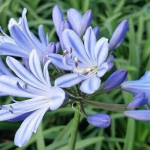
Agapanthus Streamline is an outstanding, free blooming, dwarf variety. Blue flower clusters appear in summer on long stems. Good in rockeries, amongst small shrubs as a ground cover or along a drive/footpath. Remove spent flower stems and dead leaves at the end of winter, water regulary during summer and can handle drought.
Flowering: Summer [December - January]
Fruiting:
Anemanthele lessoniana (Wind Grass, Gossamer Grass)
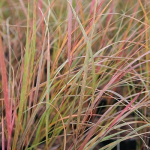
Anemanthele lessoniana, commonly known as Wind Grass, is a species of ornamental grass that is native to New Zealand. It is a perennial grass that is known for its distinctive and attractive appearance, making it a popular choice in ornamental gardens and landscapes.
Anemanthele lessoniana typically grows in clumps, with tufts of arching, narrow leaves that are about 100cm in height. The leaves are green during the growing season, but as they mature, they turn bronze or coppery in color, creating a striking display of warm hues in the garden. The leaves are thin and wiry, and they flutter and sway gracefully in the wind, giving the grass its common name, "Wind Grass".
In addition to its unique foliage, Anemanthele lessoniana produces attractive flowers in the summer months. The flowers are small, airy, and feathery, and they are typically held on tall stems that rise above the foliage. The flowers may be purplish or bronze in color, adding further interest to the overall appearance of the grass.
Anemanthele lessoniana is a hardy grass that is relatively low-maintenance. It prefers well-draining soil and is tolerant of a wide range of growing conditions, including coastal areas and exposed sites. It is also drought-tolerant once established, making it suitable for xeriscaping or water-wise gardens. Anemanthele lessoniana is typically grown as an accent plant in borders, mass plantings, or as a focal point in a garden. It is also used in dried flower arrangements, where its unique texture and color add interest and depth.
Overall, Anemanthele lessoniana is a visually appealing ornamental grass that adds a touch of elegance and movement to garden landscapes. Its unique foliage, attractive flowers, and low-maintenance nature make it a popular choice among gardeners and landscape designers alike.
Performing best when planted in full sun on a well-drained site. It is tolerant of short periods of dry, coastal conditions, frost, and cool climates, but will not tolerate prolonged wet.
Habitat: Sea level to montane forest, forest margins, scrub and on cliff faces and associated talus.
Flowering: Summer [December - January]
Fruiting: Summer [February]
Tags: DrainField
Apodasmia similis (Oioi, Jointed Wire Rush)
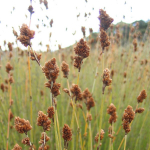
Apodasmia similis, commonly called oioi, is an attractive wetland reed with fine grey-green leaves and brownish bracts at the joints. Popular structural landscaping plant. A great option for mass planting on wet or coastal sites, growing in extremes of wind and salt.
A hardy plant tolerant of most soil types that is often used in riparian plantings. Plant communities that include Carex maorica, Carex secta, Carex virgata, Carex geminata, Phormium tenax and Eleocharis acuta often include Apodasmia similis. Recently, Apodasmia similis has become popular in landscape designs as it has an interesting texture and survives in a range of positions and is an easy NZ natives solution to wet or dry problem areas.
Habitat: Mostly coastal in estuaries, saltmarshes, dunes and sandy flats and hollows. Occasionally inland in gumland scrub, along lake margins, fringing peat bogs or surrounding hot springs.
Flowering: Spring [October - December]
Fruiting: Summer [December - March]
My Lists: DrainField, ErosionControl, Rongoa, Wetland
Arthropodium cirratum (Renga Renga, Rock Lily)
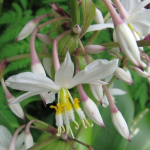
Arthropodium cirratum, commonly called Renga Renga or Rock Lily, is used widely as a ground-cover for dry shade and under trees. Forms large clumps of broad, medium-green, arching foliage. Graceful sprays of white star-shaped flowers from spring to mid-summer. Found naturally throughout NZ in coastal areas. Effective planted in groups. Tolerates coastal winds. Gets frosted back in Canterbury. Hardy.
This herbaceous perennial is grown for its foliage and flowers. It grows as a clump and bears soft and lush, dark green foliage held with a gentle arch. Masses of starry, white flowers are borne on wispy stems through spring and summer and are followed by fruits and seeds that attract birds. This plant is found naturally throughout NZ in coastal areas where it typically grows to as a tidy clump to about 75 cm tall and the same wide. It grows best when planted in full sun or partial shade on a well-drained, frost free site, though will tolerate dry and exposed conditions. The Renga Renga Lily is commonly mass planted as a groundcover, used in cottage or white gardens, included in borders, or planted around outdoor living areas.
Habitat: Found growing in dry, rocky coastal regions.
Flowering: Spring - Summer [September - December]
Fruiting: Summer [January - February]
Tags: Rongoa
Austroderia richardii (Toetoe)
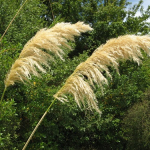 Sold Out
Sold Out
Austroderia richardii, commonly known as toetoe, is a large perennial tussock grass species that is native to New Zealand. It belongs to the family Poaceae and is endemic to the country, meaning it is found nowhere else in the world.
Austroderia richardii has distinctive features that make it easily recognizable as its one of the tallest grass species in New Zealand. The leaves are long and narrow, with a rough texture, and can grow up to 1.5 meters in length. The leaf margins are often serrated or toothed, giving them a slightly serrated appearance.
Austroderia richardii is typically found in wetland habitats, such as swamps, bogs, and riverbanks, although it can also occur in other types of habitats, including coastal dunes and forest clearings. It is an important plant for wetland ecosystems, providing habitat and food for a variety of birds, insects, and other wildlife.
Toetoe has been used by Māori, the indigenous people of New Zealand, for various purposes. The leaves have been used for weaving, thatching, and as bedding material, while the flower heads have been used for decorative purposes. Today, Austroderia richardii is also cultivated as an ornamental grass in gardens and landscaping due to its impressive size and striking appearance.
Overall, Austroderia richardii, or toetoe, is a prominent grass species in New Zealand, known for its tall stature, feathery flower heads, and importance in wetland ecosystems and cultural uses. A very tough, hardy and fast growing withstanding strong winds, costal conditions, drought and cold conditions.
On farm, Austroderia richardii is a good wind break once established as they grow in clumps and are very hardy plants that can withstand many weather conditions. Protects stock and stays below pivot irrigation, also useful in runoff prevention and along water courses. Toe toe is an attractive bank stabilisation plant, good for a range of soils and suits riparian plantings.
Habitat: Abundant, from the coast to subalpine areas. Common along stream banks, river beds, around lake margins, and in other wet places. Also found in sand dunes.
Flowering: Spring [September - November]
Fruiting: Summer [October - March]
My Lists: Coastal, DrainField, ErosionControl, Rongoa, Wetland
Brachyglottis monroi (Monros Groundsel)
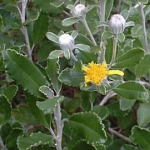
Brachyglottis monroi, commonly called Monros Groundsel, is a neat compact low spreading shrub with leaves a green to brownish-green above and whitish below. The margins of the leaves are distinctly crinkled. Superb plant in any landscape. Clusters of bright yellow flowers in summer. Hardy will grow in sun or shade, and tolerant of dry conditions. Evergreen. Hardy.
Habitat: Found in subalpine scrub among the Kaikoura Ranges.
Flowering: Summer [December - March]
Fruiting: Autumn [March - April]
Buxus sempervirens (Box Hedge, English Box)
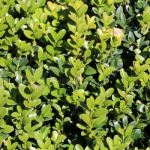
Buxus sempervirens, commonly called Box Hedge or English Box, is a bushy evergreen shrub with lush green foliage. Its valued for topiary hedging as it tolerates close shearing. A must for the formal garden. Plant them 20cm apart for a low tightly clipped formal hedge. Evergreen. Frost hardy.
The common box, European box, or boxwood, is a species of flowering plant in the genus Buxus, native to western and southern Europe, northwest Africa, and southwest Asia, from southern England south to northern Morocco, and east through the northern Mediterranean region to Turkey.
Habitat: The species typically grows on soils derived from chalk, limestone, usually as an understorey in forests of larger trees, most commonly associated with European beech (Fagus sylvatica) forests, but also sometimes in open dry montane scrub, particularly in the Mediterranean region. Box Hill, Surrey is named after its notable box population, which comprises the largest area of native box woodland in England.
Carex buchananii (Buchanan)
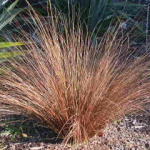
Carex buchananii is a 60 cm tall native hair sedge which forms upright clumps of very fine, hair-like leaves of a bronzy-cinnamon colour. The stiff blades curve at the end. Looks fabulous planted in large drifts. Hardy to just about any conditions but happiest in a sunny position that does not dry out completely in summer. Evergreen. Hardy.
Habitat: Coastal to montane (up to 1000 m a.s.l.). On beaches, lagoon, lake and stream margins, or in damp ground within open forest or short tussock grassland.
Flowering: Spring [October - December]
Fruiting: Summer - Autumn [November - June]
Carex testacea (Speckled Sedge, Orange Sedge)
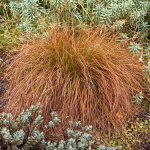
Carex testacea, commonly known as Orange or Speckled Sedge, is a clump-forming perennial grass-like plant that belongs to the family Cyperaceae. It is native to New Zealand and is widely cultivated as an ornamental plant in many parts of the world.
Carex testacea is known for its distinctive foliage, which undergoes color changes throughout the year. The leaves are typically narrow and linear, and they emerge in shades of green, gradually turning to a warm bronze, copper, or orange color as they mature. The foliage has a fine, hair-like texture, which gives the plant a unique and ornamental appearance.
The plant typically grows in dense tufts or clumps, with stems that are typically upright or slightly arching, reaching a height of 30 to 60 cm. The stems are usually smooth and glossy, and they may develop a reddish coloration towards the base.
Carex testacea is a relatively low-maintenance plant that is tolerant of a wide range of growing conditions. It prefers well-draining soils and can tolerate partial to full sun, although it may exhibit more intense coloration in brighter light. It is drought-tolerant once established, making it suitable for water-wise gardens. Evergreen. Hardy.
Habitat: Coastal to montane. In sand dunes, coastal forest and scrub, dense forest or short tussock (Festuca novae-zelandiae) grassland.
Flowering: Spring [September - December]
Fruiting: Summer [December - May]
Ceanothus prostrata (Californian Lilac)
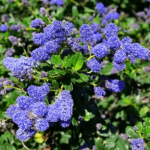 Sold Out
Sold Out
Compact spreading bush with mass clusters of dark-blue flowers in late spring. Very dark foliage. Flourishes in tough conditions with minimum watering and full sun. Perfect for mass planting and weed suppressing ground cover. Evergreen. Hardy.
Flowering: Spring - Summer [September - January]
Fruiting:
Chionochloa rubra (Red Tussock)
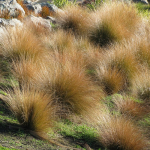
Chionochloa rubra, commonly known as Red Tussock grass, is a species of tussock that is native to New Zealand. It is a perennial grass that belongs to the Poaceae family and is known for its distinctive appearance and ecological importance.
Chionochloa rubra forms large, dense tussocks that can reach heights of up to 1.5 meters tall, although some specimens can grow taller in favorable conditions. The leaves are long, narrow, and stiff, with leaf edges are often rolled inward, giving them a tubular appearance. The tussocks are often reddish-brown at the base, which gives the species its common name "red tussock."
Chionochloa rubra plays a vital ecological role in New Zealand's ecosystems. The dense tussocks provide shelter and nesting sites for native birds. The tussocks also help prevent erosion by stabilizing soil with their extensive root systems, and they can trap and store snow, which helps regulate water flow in alpine catchments. Additionally, Chionochloa rubra is an important food source for native insects and other herbivores, and it contributes to nutrient cycling in the ecosystem.
Red tussock is a most adaptable vegetation which will grow in the exposed and windy environment. It can tolerate low-nutritious, and also can grow in relatively wet or dry soil conditions. It is harsh enough to use one individual specimen plant however, if space allowed, would be better for planted several as a group. Red tussock is a useful vegetation for helping to reestablish wildlife habitat, especially useful as a buffer plant around wetland areas.
Habitat: Subalpine to alpine (rarely upper montane). Often the dominant of tussock grassland, also found within shallow bogs or fringing the margins of deeper bogs and small ponds, tarns and slow flowing streams. Occasionally in canopy gaps in upper montane forest or within subalpine scrub.
Flowering: Spring [October - December]
Fruiting: Summer [November - May]
My Lists: DrainField, ErosionControl
Choisya ternata (Mexican Orange Blossom)
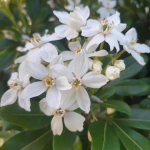
Choisya ternata, commonly called Mexican Orange Blossom is a hardy, evergreen shrub with glossy dark green fragrant foliage and has a dense habit maintaining a natural rounded shape. Choisya ternata produces clusters of pure white flowers lasting months throughout spring, summer and autumn. It is happy growing in sun or shade and alongside many other plants preferring an open free draining soil. Fantastic for hedging or as a gap-filler in the garden. Hardy.
Flowering: Spring - Summer [September - November]
Fruiting:
Cistus Bennett's White (Rock Rose)
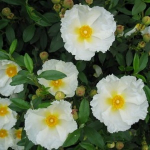 Sold Out
Sold Out
Cistus Bennett's White, or Rock Rose, is a fabulous shrub for hot, dry or coastal conditions. The coarse green foliage and large papery white flowers with their bright yellow centres make a real show from spring through to summer. Benefits from a trim after flowering.
Cistus Brilliancy (Rock Rose)
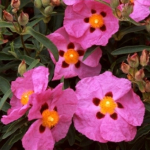 Sold Out
Sold Out
Cistus Brilliancy, Rock Rose, makes a 'Brilliant' show in summer when the aromatic foliage is smothered with rich rosy pink flowers with deep maroon markings and yellow centers. Hardy to most conditions. Great for hot dry spots. Very reliable. Prune lightly after flowering to maintain shape.
Cistus Sunset (Rock Rose)
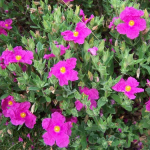 Sold Out
Sold Out
Cistus Sunset, or Rock Rose, is a superb little shrub for those hot dry spots in the garden. The aromatic grey leaves are decorated with hot rose pink flowers off and on throughout the year. Loves warmth and needs a well drained spot. Benefits from a trim every now and then.
Coprosma Copper Shine (Mirror Bush)
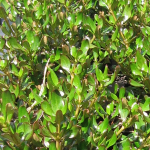
Coprosma Copper Shine is tough and hardy evergreen shrub has gorgeous foliage with round, glossy leaves that are tipped with copper tones year-round for attractive garden contrast. Growing 1 - 2 metres high and wide, the density of the foliage lends extremely well to hedging, screening and windbreaks. Perfect for coastal gardens, mixed beds, and container planting. Tolerates dryness. Evergreen.
Coprosma rugosa (Needle-leaved Mountain Coprosma)
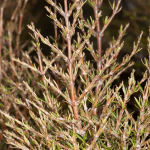
Coprosma rugosa is a hardy native shrub good for exposed sites. A divaricating shrub selected for its texture and structure. Excellent for mass planting, hedged or low maintenance, structure plantings. Evergreen. Hardy.
Habitat: Found in lowland, montane and subalpine grasslands, scrublands and forest margins.
Flowering: Spring [October - November]
Fruiting: Autumn [February - April]
Tags: DrainField
Corokia cotoneaster (Korokio)
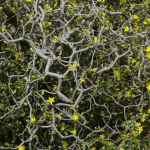
Corokia cotoneaster, or Korokio, is a good hedging and ornamental shrub. Corokia cotoneaster prefers to survive in areas that are not wet. It will grow and develop in dry, rocky, and dense soils. Attractive fine silver/grey foliage with bright yellow flowers in early summer. Densely interlaced branchlets. Red berries/seed. Evergreen. Very hardy to drought and cold.
As it is a tough plant that attracts birds and lizards, it is suitable for restoration projects. As part of the dry woodland community, it plays an important role in conditioning the soil. The soil conditioning creates a more hospitable environment for less robust species and broadleaf/podocarp forest succession. Other plants in this community include but are not limited to Discaria toumatou, Poa cita, Ozothamnus leptophyllus, Sophora prostrata, Melicytus alpinus and Cordyline australis.
Habitat: Found in scrub and on dry river flats and rocky places throughout the country.
Flowering: Spring [September - December]
Fruiting: Summer - Autumn [January - May]
Tags: DrainField, PoorSoils
Dianella nigra (Turutu, NZ Blueberry)
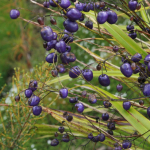
Dianella nigra, Turutu, has bright iridescent blue berries in summer, this small evergreen flax like plant works well in most situations and is especially attractive planted naturally in groups. Ideal for dry areas under existing vegetation. Turutu grows up to 50 cm tall and about 50 cm wide, making it a perfect smaller substitute for flaxes and does much better in semi shade than the unrelated mountain flax. The magnificent bright blue and fleshy berries that arise during summer from tiny white flowers with yellow stamens. The berries are spread and eaten by native birds.
Habitat: Coastal to montane (rarely subalpine) . Colonising a wide variety of habitats from open coastal headlands, gumland scrub and less frequently peat bogs through to dense forest and subalpine scrub.
Flowering: Spring [November - December]
Fruiting: Summer - Autumn [December - May]
Festuca actae (Banks Peninsula Blue Tussock)
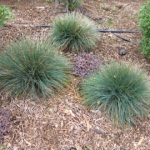
Festuca actae, commonly called Banks Peninsula Blue Tussock, is a small tussock with fine rolled blue foliage from Banks Peninsula. The erect flowering stems reach 75cm. Tolerates full sun but grows best in light shade in southern climates. The showy yellow flowers in late spring bring interest to the garden and can provide food for birds in autumn.
Habitat: Coastal to montane. On rocks, rock outcrops, bluffs, talus and stabilised, sparsely vegetated slopes.
Flowering: Spring [October - December]
Fruiting: Summer - Autumn [November - April]
Tags: PoorSoils
Helianthemum Pink (Pink Rock-Rose)
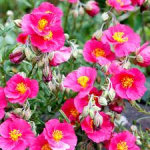
Helianthemum, commonly called Rock Rose, is a low growing shrubby perennial with woody dark green-grey foliage, pink flowers with yellow centre. Ideal for rockery in a sunny spot. Found in the North Atlantic region, mainly in dry grassy and rocky places across large parts of Europe.
Flowering: Summer [November - February]
Fruiting:
Helianthemum White (White Rock-Rose)
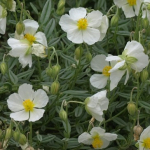
Helianthemum, commonly called Rock Rose, is a low growing shrubby perennial with woody greenish grey foliage, comes in white flowers with yellow centres. Ideal for rockery in a sunny spot. Found in the North Atlantic region, mainly in dry grassy and rocky places across large parts of Europe.
Flowering: Summer [November - February]
Fruiting:
Helleborus orientalis (Winter Rose)
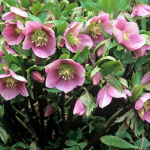
Helleborus orientalis, commonly called Winter Rose, is a winter-flowering staple in the cottage garden, hellebores produce large clusters of saucer-shaped flowers with white, pink, green, mauve or smoky purple flowers. The large leathery, evergreen leaves persist throughout the year but should be cut back in the spring when flowers and new foliage emerge.
Happiest in semi-shade and humus rich well drained soil. Eventually forms a large clump and will really stand out in the winter garden.
Hoheria angustifolia (Houhere, Narrow-leaved Lacebark)
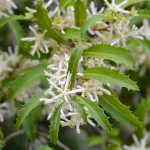 Sold Out
Sold Out
Hoheria angustifolia, Houhere, commonly known as Narrow-leaved Lacebark, is a tree native to New Zealand. It is a member of the family Malvaceae and is known for its striking appearance, with its slender leaves and attractive flowers. The leaves of Hoheria angustifolia are narrow and lanceolate.
The flowers of Hoheria angustifolia are one of its most distinctive features. They are typically large and showy, measuring 1.5-2 cm in diameter and arranged in clusters at the tips of the branches. The flowers are usually white and fragrant, and attract pollinators such as bees and butterflies.
The bark of Hoheria angustifolia is smooth and greyish-brown when young, becoming rougher and more fissured with age. The bark peels off in strips, revealing a lighter colored inner bark, which adds to its aesthetic appeal.
Hoheria angustifolia is primarily grown as an ornamental tree in gardens and parks, appreciated for its graceful form, attractive flowers, and interesting bark. It is also used in ecological restoration projects for its ability to attract pollinators and provide habitat for birds and insects.
History of use: The inner bark of Hoheria angustifolia has been used traditionally by Maori for making rope and twine.
Habitat: A common mostly lowland forest species frequenting alluvial forest where it may at times be dominant. Hoheria angustifolia is often an important host for taapia (Tupeia antarctica).
Flowering: Summer [December - March]
Fruiting: [February - April]
Tags: Rongoa
Lavandula angustifolia (English Lavender)
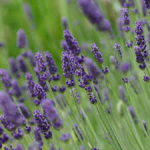 Sold Out
Sold Out
Lavandula angustifolia, commonly called English Lavender, is a sun loving perennial herb plant with mid to late spring bloom time. It is known as a xerophyte which by definition is a plant that has adapted to living in dry climate conditions. Poor soils are not a problem and are in fact preferred over rich moist ones. This makes Lavender perfect for sun drenched planting locations such as a hot dry bank that can be a real landscape problem area and can still withstand cold conditions during fall and winter. Evergreen. Hardy.
Excellent for crafts and dried flowers as they retain their color.
English Lavender (Lavandula angustifolia), also called True Lavender or Common Lavender is a type of lavender often associated with the famous purple lavender fields of Provence. Despite its common name, it is not native to England, but to the Mediterranean and counts over 40 different cultivars with flower spikes varying from blue-purple, lavender, violet-blue to white-pink.
Flowering: Spring - Summer [November - March]
Fruiting:
Lavandula dentata (French Lavender)
 Sold Out
Sold Out
Lavandula dentata, also known as French Lavender, is most often grown in pots or tubs, to be wintered indoors in all but very mild winter regions. Plants form a bushy shrub of grey-green, finely-toothed fragrant leaves, bearing short spikes of lavender-mauve flowers in midsummer. Easily pruned to keep a compact size. Choose a location with excellent drainage. In regions with clay soils, a raised bed or rock garden will improve success greatly. Attractive to butterflies.
Dentata flower year round but are less prolific during a hot, dry summer. They need a severe pruning at least once a year to maintain shape and prevent them from going woody - best time for a hard prune is October.
Flowering: Summer - Autumn [December - May]
Fruiting:
Lavandula stoechas (Spanish Lavender)
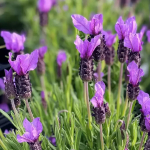 Sold Out
Sold Out
Lavender stoechas, is distinguished from other lavenders by its unusual flower blossoms. The flowers are typically purple, although they can also be pink or white, and are topped with distinctive “rabbit ears” or bracts that resemble wings.
Stoechas is used ornamentally in the garden and the flowers may be used to make Lavender sachets, Lavender wreaths and other dried floral arrangements. The flowers of Lavandula stoechas may be dried and used just like any others in the species.
Spanish lavender is native to the Mediterranean region and is a perfect fit for a Mediterranean-style garden. Combine it with other Mediterranean plants like rosemary, thyme, and sage for a garden that is both beautiful and functional.
Flowering: Spring [September - December]
Fruiting:
Muehlenbeckia astonii (Pohuehue)
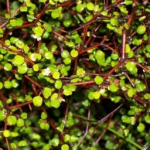 Sold Out
Sold Out
Muehlenbeckia astonii, Pohuehue, is a coastal divaricating shrub with a wiry interlacing habit. Small, bright-green heart-shaped leaves. This plant is extremely hardy, tolerating dry conditions and wind. Popular landscaping plant, providing great contrast. Makes an attractive topiary or hedge. Attracts birds, insects and lizards. Semi-deciduous. Hardy.
Unlike most New Zealand plants M. astonii is leafless in winter. This is when the distinctive branches add interest to the garden. It grows from a distinct trunk and has many fine reddish-brown to orange flexible branches that zigzag around one another to form a dense, interwoven ball. Its flowers, appearing from December to January, are tiny and are greenish to white or pinkish white. The fruits are sweet and edible, eaten by birds and lizards. The plant is an important host for several endemic insect species and in some cases their sole host.
Habitat: Coastal to lowland. This species is associated with “grey” scrub communities, largely confined to drier lowland parts of eastern New Zealand. It is found on moderate to high fertility soils. Its deep root system helps it survive in dry conditions, and can grow on open rocky hillsides and stony ground. It prefers free-draining, warm, sunny slopes, such as the mid-dune areas along the coast. The plant is often found in association with Coprosma crassifolia, Coprosma propinqua, Muehlenbeckia complexa, Discaria toumatou, Olearia solandri and Ozothamnus leptophyllus.
Flowering: Spring - Summer [August - January]
Fruiting: Summer - Autumn [October - June]
Tags: Rongoa
Olearia lineata (Small-leaved Tree Daisy)
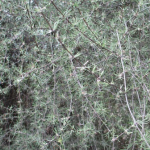
Olearia lineata is one of the best native plants for hedging with fine grey, willowy foliage. Fast growing and hardy, forming a graceful tree, bearing masses of erect twigs with clusters of small very thin leaves that are white underneath, on the margins of steep river gorges and amongst rocky outcrops. Bushy tree up to 6m tall with a fragrant white flower. Evergreen. Hardy.
Habitat: A rare, at-risk and in decline tree endemic to the South Island of New Zealand. Found mostly in the east in damper sites from lowland to 300m above sea level. Found on tussock grassland and forest margins, river terraces. Also found on the margins of steep river gorges, and amongst rock outcrops, boulder field and at the toe of alluvial fans.
Flowering: Summer [November - January]
Fruiting: Autumn [January - April]
Tags: RarePlant
Ozothamnus leptophyllus (Tauhinu, Cottonwood)
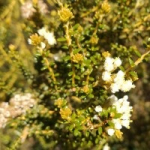
Ozothamnus leptophyllus, commonly called Tauhinu or Cottonwood, is a bushy shrub with small silver green leaves with fine silver hair beneath. The stems silver/white in colour. It has an attractive silver-grey appearance and flowers in profusion with clusters of tiny cream daisy (wheel-shaped) flowers followed by down-covered seed heads.
Ozothamnus leptophyllus is fast-growing, reaching its maximum height of 2 metres in 10–15 years. Tauhinu can readily colonise bare hillsides and pasture, with seeds readily dispersed by the wind. It grows rapidly, acting as a nursery plant for other species. Unless their under storey plants are heavily grazed, tauhinu shrublands are usually overtopped by taller shrubs and trees. Because of this, Tauhinu makes an excellent coastal or dry woodland revegetation plant. Seeds readily dispersed by the wind. It prefers a sunny location and is frost hardy.
Habitat: Found in coastal to subalpine shrubland.
Flowering: Summer [December - March]
Fruiting: Autumn [March - April]
Tags: PoorSoils
Phormium cookianum (Wharariki, Mountain Flax)
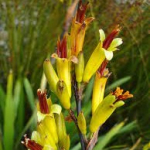
Phormium cookianum, Wharariki, is commonly called Mountain Flax, is a superb species, one of the hardiest and the most striking. Long arching green leaves all year round, and 2 metre long flower stalks over summer - particularly attractive to native birds. Use as a 'groundbreaker' in new gardens, en masse on banks. Foliage and flowers are great for floral artwork.
Phormium cookianum is a flax up to 1-3 metres tall but generally smaller than Phormium tenax. The numerous leaves are 5-12cm wide, thick, fibrous, droopy, and rise from fan-like bases. The tubular 25-40 mm long flowers are a dull pink or yellow colour. The seed capsule is pendulous and twisted.
Habitat: Strictly confined to subalpine, alpine situations, where it mainly grows on cliffs and mountain slopes, in seepages, along stream sides or on the margins of bogs.
Flowering: Spring [October to December]
Fruiting: Summer [January to March]
Tags: Coastal, DrainField, Rongoa
Phormium cookianum Purpurea (Purple Mountain Flax)
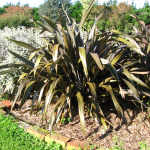
Phormium cookianum Purpurea is a red foliaged variety of the Mountain Flax. Flower spikes rise above the plant and bear twisted looking flowers, to which birds are attracted for the nectar. Curiously, many of the red varieties don't flower, however the purples, greens and yellows do.
Flowering: Spring [October to December]
Fruiting: Summer [January to March]
Tags: DrainField
Poa cita (Wi, Silver Tussock)
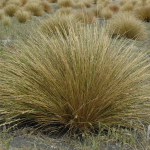
Poa cita, Wi, or Silver Tussock, is a densely tufted tussock of a graceful habit. Fine shiny silvery-green erect foliage with a flowing habit. Slender flowering stem, tawny coloured. Best in poor dry soils in an open situation. Excellent for mass planting. Great for exposed windy sites.
Habitat: Preferring a full sun position, tolerant of light shade, coastal conditions, and drought. Poa cita is often found in dry woodland and grassland plant communities
Flowering: Summer [November - December]
Fruiting: Summer [January - February]
Tags: PoorSoils, Rongoa
Rosmarinus prostratus (Creeping Rosemary)
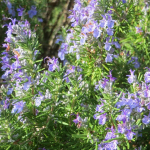
Rosmarinus prostratus, Prostrate Rosemary, or Creeping Rosemary, is a low-spreading, evergreen shrub or groundcover. Its leaves are green, leathery and very aromatic. This Creeping Rosemary has pale-blue flowers from early to mid-summer. Rosmarinus officinalis Prostratus can be used as a beautiful groundcover because of its height which reaches only up to 30cm and 150cm in its spread. Creeping Rosemary will trail over walls or edge of a raised bed to make a curtain like effect.
Culinary herb and many medicinal uses. This herb, especially the flower tops, contains antibacterial and antioxidant rosmarinic acid, plus several essential oils such as cineol, camphene, borneol, bornyl acetate, and α-pinene that are known to have anti-inflammatory, anti-fungal, and antiseptic properties. Many sources document rosemay’s effect on improving memory, slightly fewer mention its ability to attract lovers, and repel nightmares! Use woody stems as skewers on BBQ to impart flavour. Very drought tolerant. Full sun.
Flowering: Summer - Autumn [December - May]
Fruiting:
Rosmarinus Tuscan Blue (Upright Rosemary)
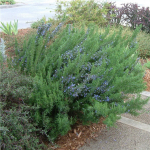
Rosmarinus Tuscan Blue is a large evergreen, upright Rosemary with a good flavor making it an excellent culinary herb, or a landscaping shrub. As an herb, Rosemary is used to flavor meat dishes, and condiments. The small blue flowers that appear in mid summer are edible as well, and make a nice garnish for salads. In the landscape Rosemary is used in hot, sunny locations as it is very drought resistant and withstands the heat and humidity well.
Many sources document rosemary’s effect on improving memory, slightly fewer mention its ability to attract lovers, and repel nightmares! A lovely children’s herb for this folklore reason but also due to its lingering scent, and its ability to take quite a battering from constant harvest for teas and ‘potions’.
The woody stems can also be used as skewers on the BBQ to impart flavour. Very drought tolerant. Full sun. Height to 2m.
Flowering: Spring - Summer [September - March]
Fruiting:
Santolina chamaecyparissus (Cotton Lavender)
 Sold Out
Sold Out
Santolina chamaecyparissus is commonly known as Cotton Lavender, this is a small shrub grown for its foliage and flowers. It produces a dense network of small and aromatic, grey-green leaves, cypress-like and acts as an insect repellent.. The foliage is adorned with mass of yellow, button-like flowers in summer. Flowers can be used in floral arrangements.
This evergreen grows with a rounded. It performs best when grown in full sun on a well-drained site, noting that is hardy to dry periods, coastal environments, and moderate frost once established. The Cotton Lavender is commonly included in borders, mass planted as a ground cover, maintained in a container, included in cottage or Mediterranean gardens, or planted around outdoor living areas. It is an easy plant to grow and very rewarding. A pretty cottage plant. Cut back after flowering.
Flowering: Summer [December - February]
Fruiting:
Sophora microphylla (South Island Kowhai)
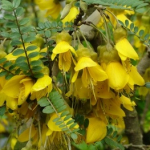
Sophora microphylla is also known as South Island Kōwhai, having showy yellow flowers in early spring. This particular Kōwhai has very small leaves (microphylla) and a tangled juvenile form, tending to straighten up and grow from an upright trunk at about four years. Kōwhai makes a good garden tree and is necessary for revegetation projects as a bird attractor. Kōwhai are suited to upper bank plantings of riparian areas. They also make beautiful shade or specimen trees. Semi-deciduous. Hardy.
Sophora microphylla have horn-shaped yellow flowers. The nectar is a favourite food for Tui, Bellbird and Kererū which also eat the leaves. The seed pods which appear after flowering stay hanging on the tree through winter.
Kōwhai is the national flower of New Zealand.
Habitat: In the North Island, especially the northern half this is a species of mainly riparian forest. South of Hamilton it can be found in a diverse range of habitats from coastal cliff faces and associated wetlands to inland grey scrub communities. Sophora microphylla and Sophora prostrata are the only forms naturally existing in Canterbury.
Flowering: Winter [August - October]
Fruiting: Spring - Summer [October - May]
Tags: Rongoa, WinterPollen
Sophora prostrata (Dwarf Kowhai)
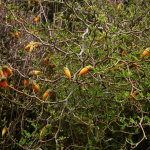
Sophora prostrata, commonly known as Dwarf Kowhai, is a low-growing shrub or small tree species that belongs to the family Fabaceae. It is native to New Zealand and is known for its vibrant yellow flowers and unique, prostrate growth habit.
One of the most distinctive features of Sophora prostrata is its striking yellow flowers, which are pea-like in shape and arranged in clusters at the ends of the branches. The flowers usually appear in late winter or early spring, and their bright yellow color is a standout feature against the dark green foliage. The flowers are attractive to bees and other pollinators.
Sophora prostrata is endemic to New Zealand, where it is found in a variety of habitats including coastal cliffs, sand dunes, shrublands, and forests. It is particularly well-adapted to tolerate salt spray and harsh coastal conditions, which makes it suitable for coastal gardens and landscaping.
Sophora prostrata serves as an important host plant for the caterpillars of several native butterfly species. Additionally, Sophora prostrata is a popular ornamental plant in gardens and landscapes due to its attractive flowers and unique growth habit. Semi-deciduous. Very tough on exposed, cold, dry sites.
Habitat: Found from the coast to subalpine in open rocky planes. Confined to the eastern South Island from Marlborough to the Waitaki Valley.
Flowering: Spring [September - October]
Fruiting: Summer [January - February]
Tags: PoorSoils
Teucrium chamaedrys (Wall Germander)
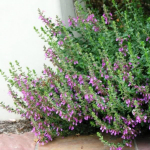
Teucrium chamaedrys, commonly called Wall Germander, is a evergreen subshrub grown for its attractive, dark green aromatic foliage and its light pink to deep purple flowers, which blossom in summer and early fall. This garden workhorse can be used in troughs, containers, low hedges, knot gardens, rock gardens, or as edging.
Flowering: Summer [November - March]
Fruiting:
Teucrium fruticans (Silver Germander)
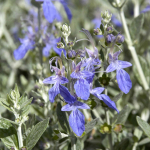
Teucrium fruticans, commonly called Silver Germander, is a hardy and fast growing with lavender-blue flowers. Plant in a hot, sunny area of the garden. Doesn't like wet feet. Clip regularly to maintain a formal hedge. When it gets woody it can be trimmed to ground level to rejuvenate the plant. Handles dry, coastal conditions but responds to summer watering. Contrast plant against dark backgrounds. Useful as both a formal or informal hedge and for topiary.
Flowering: Summer [November - January]
Fruiting:
Veronica decumbens (Hebe decumbens)
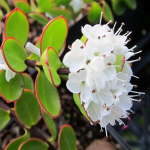
Veronica decumbens, formerly known as Hebe decumbens, is native to the North Canterbury region, has shiny dark green leaves with a red margin. Bears tiny white flowers from late spring to summer.
Habitat: Found among mountains from Nelson to Canterbury on rocky ledges at around 1,000 - 1,400m.
Flowering: Summer [December - February]
Fruiting:
Veronica odora (Hebe odora, Boxwood Hebe)
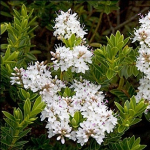
Veronica odora, formerly known as Hebe odora, is a rounded NZ native Hebe has dark green box-like foliage and racemes of white flowers in summer. Can be clipped to maintain a neat shape and makes an attractive hedge. Light prune and feed after flowering to maintain shape and promote new growth.
Habitat: It grows in montane to penalpine grassland, shrubland, bogs and flushes.
Flowering: Summer [October to March]
Fruiting:
Veronica Oratia Beauty (Hebe Oratia Beauty)
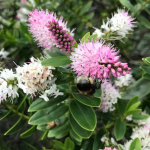
Veronica Oratia Beauty, formerly known as Hebe Oratia Beauty, with pale pink flowers that fade to white. The fleshy leaves are spear-shaped like other Hebes but are broader. Good tidy growth habit. Prefers exposed position in garden.
Flowering: Summer [December - February]
Fruiting:
Viburnum tinus Lucidum (Viburnum)
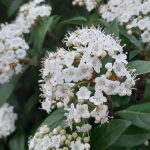
Viburnum tinus 'Lucidum' is a cultivar of Viburnum tinus, a popular evergreen shrub known for its attractive foliage, fragrant flowers, and colorful berries. 'Lucidum' is a variety of Viburnum tinus that is characterized by its glossy, dark green leaves, which are oval in shape and have a leathery texture.
The leaves of Viburnum tinus Lucidum have a lustrous appearance, with a shiny surface that gives them their name "Lucidum," which means glossy or shining. The leaves provide year-round interest, as they remain on the plant throughout the winter, retaining their green color even in colder months.
In addition to its glossy foliage, Viburnum tinus Lucidum produces clusters of small, fragrant flowers in late winter to early spring. The flowers are typically white or pale pink and are borne in rounded clusters known as cymes. The flowers are attractive to pollinators, such as bees and butterflies, and add a splash of color to the winter garden.
After flowering, Viburnum tinus 'Lucidum' produces small, fleshy berries that change color as they mature. Initially green, the berries turn to shades of pink and then eventually to a dark blue-black color. These berries are a valuable food source for birds, adding wildlife interest to the garden.
Viburnum tinus 'Lucidum' is a versatile shrub that can be used in various garden settings, such as mixed borders, hedges, or as a focal point. It is relatively low-maintenance and can tolerate a wide range of growing conditions, including partial to full sun and well-drained soils. It is also fairly drought-tolerant once established. Overall, Viburnum tinus 'Lucidum' is valued for its glossy foliage, fragrant flowers, and attractive berries, making it a popular choice for many gardeners.
Flowering: Winter - Spring [June - November]
Fruiting: Autumn - Winter [March - August]
